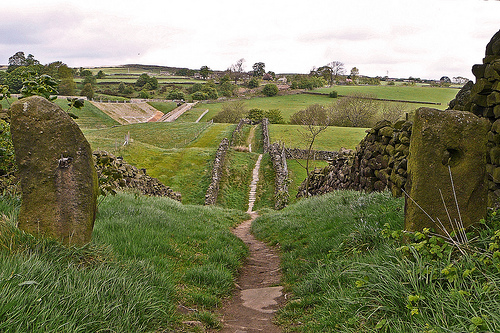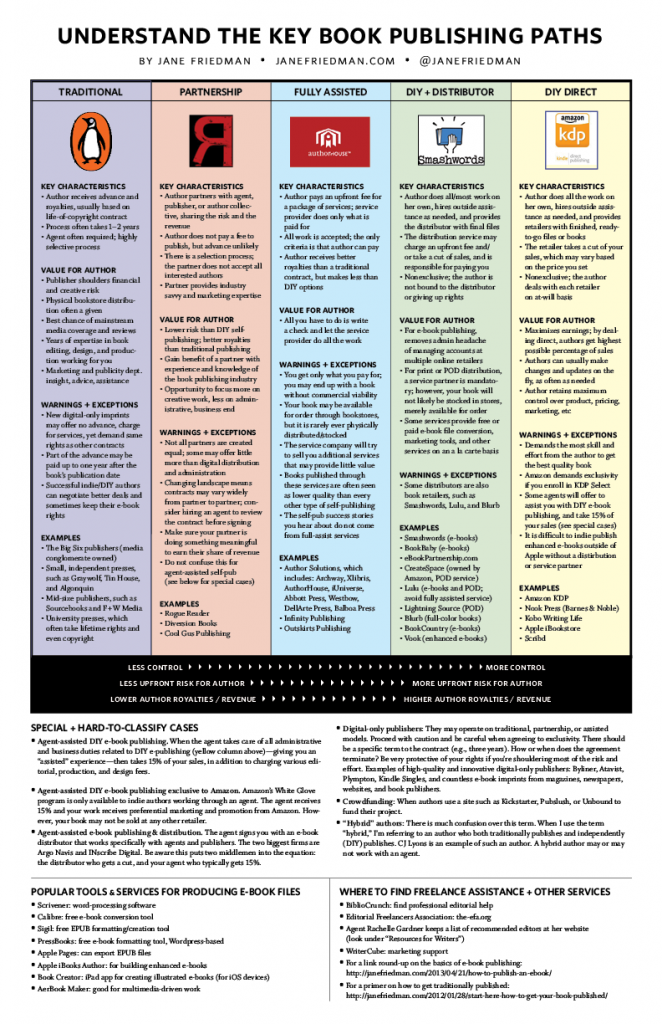
A few weeks ago Jane Friedman published an infographic that outlined the "Key Book Publishing Paths." There has been much sharing and debate over the routes she put forward. For instance, she herself sends people to read Mick Rooney's response to the infographic. The debate is a very worthwhile one, and I think the conclusions we collectively come to over the next few years as we emerge from the publishing option soup that we are all currently swimming in will go a long way to setting the foundation for the future of how authors think about the publishing process. Already we have passed the threshhold where authors think that it's a traditional publishing house or a vanity press, but we are far from understanding what works and what's snake oil in the grey area of hybrid/DIY/self-pub/assisted-publishing world.
I'm not going to dig into the debate of how well the infographic represents the key publishing paths or talk about the nuances or outright differences between them and/or other paths. What I want to look at today is what the aggregate message of the 5 paths means for the future of publishing as an industry. We don't know what will emerge as effective and popular, but we do know what the trajectory and direction is at this point. I can't predict what the publishing world will look like in 5 years, but I do think what we're doing and thinking about now offers important lessons about how authors and publishers are thinking and what we both want. From those emotional world-views, I think we can pull some valuable clues as to what kinds of trends will emerge.

What the 5 Key Paths could imply
Friedman outlines these 5 key publishing paths, and I've paraphrased her descriptions:
- Traditional publishing (authors query through agents, publisher does the work, author gets an advance)
- Partnership publishing (where authors are positioned more as partners, receive higher royalties, but usually no advance)
- Fully-assisted publishing (author writes a check and book is published without him/her lifting a finger: vanity publishing)
- Do-it-yourself (DIY) publishing with a distributor (applies to either print or e-books- involves e-publishing and using a service provider or distributor to reach all possible online retailers—and/or to provide some level of assistance)
- Do-it-yourself (DIY) direct publishing: (no middlepeople between author and the retailer, ie Amazon)
Ten or twenty years ago, it was pretty much a choice between #1 and #3. So, what threads tie the three new options together?
1. Control for the author. For me, the most telling thing about this infographic is that 4 of the 5 key paths are driven by the author having more control over his or her work than in the traditional publishing track. Even more importantly, it means the author takes on more of the risk and responsibility around what it means to publish the book.
2. Money for the author. In the same breath, if the author is doing a large chunk of the publishing production and marketing work, the author is also getting higher royalties. That doesn't necessarily or even commonly mean that an author is making more money from a given book, but it does mean that the amount an author makes off of one single book sale is higher. The trick is, of course, getting as many or more book sales on your own as a publisher can or will get with their established distribution network.
So, what does it mean for the future of publishing?
1. Control: I think this is the #1 trend. Authors want and are taking more control of the process of publishing. We don't know yet where the line will be most effectively drawn. Do we get better books if authors choose their own editors and do their own marketing? Or will we find that the books coming out of houses where there are more full time teams actually produce better books? We don't know that yet. I can see a future where publishing houses allow authors to choose from curated teams of professionals. This way the publisher has someone they know and trust, and the author feels more in control of who is editing their opus.
2. Money: The money part is crazy. Publishers, retailers, and authors are all grabbing for a piece of that pie. Right now, everyone has a different scheme for how the money gets divided. And that's fine, but I don't think it will last. Everyone will gravitate toward the best deal for them. So what will that look like over time? I think authors will want a set percentage from a book sale- clarity along the lines of "I get 25% of the cost of each book" or something like that. Retailers will need to know that they make a profit on each book, as will publishers. I think as we figure out what the average cost of producing an ebook can be, we'll see profit to each of those parties become more public and standardized.
3. Service: I think publishing houses, while still harbors of extreme talent for all aspects of book production, will become more service-oriented and less gate-keepers. And I think that will be good for everyone involved.
What do you think these 5 key paths mean for the future of publishing as an industry?
Image sources: Lead from Tim Green, Infographic from JaneFriedman.com

2 comments